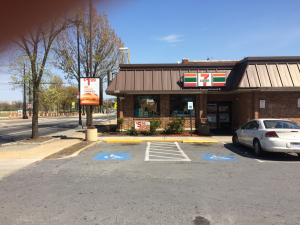By Katherine Pearson, Director of Accessibility Rights
In December, CBS’s 60 Minutes highlighted the Americans with Disabilities Act (ADA) in a segment on drive-by lawsuits. The piece focused on the assumed strain that complying with the ADA puts on small businesses and how serial complaint filers can appear to be playing the system. The program identified Google lawsuits, where Google Earth can be used to find alleged violations and file drive-by lawsuits, in which plaintiffs cite violations without exiting their vehicle, as frivolous ploys, since people did not have to be customers to file claims:
“You might think you have to be a customer of a business to file a lawsuit against it, but in some states you don’t. You can simply drive by a store or restaurant, and if you see a sign in the wrong spot, or a ramp that’s off by a few inches, you can sue.[1]”
In response to calls from businesses, Congress proposed bills that would give advanced notice of ADA violations before they could be sued. But complaints filed against companies through the ADA serve a valuable purpose in enforcing a law that is almost thirty years old. Why is no one asking why there are still so many violations of the ADA in the first place? The ADA has been in effect since 1990; how long should people with disabilities have to wait for businesses to become accessible?
A Closer Look at Drive-By & Google Lawsuits
Educating able-bodied people about the law and their potential violations of the law should not be the responsibility of the person with the disability. From a business’s perspective, drive-by lawsuits are seen as unfair because businesses claim that people with disabilities are not discussing violations with managers and personnel inside their establishments. But by definition drive-by lawsuits handle ADA violations outside of places of business, like in parking lots where lack of accessibility could make entering an establishment and discussing a violation unfeasible to begin with. For Google lawsuits, the 60 Minutes segment highlighted a hotel owner who was sued for not having an accessible pool. He stated the injustice of his situation by saying that: “At no point in time we ever had a customer on the property that requested it or that was even in a room that requested it.”[2] But that sentiment is part of the problem. In the age of Google, can this business owner really be surprised that no one with a disability would choose to stay in an inaccessible hotel? That does not mean that there was not a burden placed on people with disabilities who had to search extensively for an accessible place to stay. Nor should it be their burden to request that a business comply with a 27-year-old law.
Why Notice is Not the Answer
In 2016, Congress proposed three ADA notification bills with bipartisan support that would allow businesses extra time to comply with the ADA before they could be litigated against.[3] In cases of large businesses and convenience stores, this law would place unnecessary fiscal and financial burdens on complainants. Large chains can and do refuse to create internal training, or barrier removal plans in compliance with the ADA. Many only respond once legal recourse has been sought. The ERC often documents violations in the District that have been expressly litigated elsewhere. The narrative that drive-by lawsuits and Google lawsuits are simply a nuisance enforces businesses’ power to ignore the law.
7-Eleven as a Case Study
The ADA was created to impart practical, structural solutions to allow for physical accessibility. While Anderson Cooper or business owners may not understand why a parking space needs to be a certain width or why a sign needs to be mounted correctly, this does not mean it is not important. The following photos, taken by the ERC in 2016, show how violations can cause impractical and unnecessary barriers on people with disabilities.

Although there is an access aisle, the ADA requires that the access aisle be level with the parking lot because if someone with a wheelchair were to pull into this parking spot, they’d be unable to exit their vehicle because of the presence of the ramp.

Even though this 7-Eleven location has two accessible parking spaces and an access aisle, there is no ramp from the access aisle to the sidewalk. Instead it ends in a curb that a wheelchair could not overcome. A person using a wheelchair would have to move into oncoming traffic to get to the sidewalk on the left.
The ERC believes 7-Eleven’s violations are significant because this is not the first time such infractions have been brought to light. In Orange County, Florida, a case was filed by a loyal patron who visited all 7 different locations at least once a week to purchase goods and experienced violations.[1] In another Florida case, violations were cited in thirty-eight separate locations statewide.[2] Not only has 7-Eleven been sued under the ADA for these physical violations, but they have also been sued multiple times for employment discrimination on the basis of disability.[3] In 2014, the owner of one 7-Eleven store in New Jersey bowed to public pressure and apologized to a veteran who was kicked out of the store because he was accompanied by a service animal.[4] Over and over again, 7-Eleven has failed to implement training requirements that would prevent breaches of service or employment policies and has ignored the ADA’s structural requirements to comply with the law. Despite being dragged through the media and brought to court for ADA violations, 7-Eleven stores in DC still fail to comply with the law. No one can argue that 7-Eleven does not know that they have accessibility issues or that more notice would solve the problems we are seeing in DC, NY, and NJ.
Conclusion
People continue to encounter physical barriers to equal access. This narrative decrying drive-by lawsuits and Google lawsuits vilifies those trying to enforce a 27-year-old law without trying to understand how physical barriers to accessibility affect people’s lives. Instead media coverage comes from a place of ignorance. If lawsuits for a company in Florida meant change in DC, maybe the prevalence of litigation could be deemphasized. But state cases have only created statewide solutions therefore placing further burdens on people with disabilities to file in multiple jurisdictions. Notice that makes it more difficult for people with disabilities to assert their right to access is not the answer. It would only make it easier for companies to ignore the law. The sheer number of ADA complaints filed in this country is alarming. But it should show us how inaccessible our communities still are 27 years after the passage of the Americans with Disabilities Act. For advocates and people affected, legal recourse, including drive by and Google lawsuits, is a crucial tool for advancement.
____________________________________________________________
[1] http://www.cbsnews.com/videos/drive-by-lawsuits/ [2] http://www.cbsnews.com/news/60-minutes-americans-with-disabilities-act-lawsuits-anderson-cooper/ [3] http://www.advocacymonitor.com/ada-notification-and-then-there-were-three/ [4] Elrod v. 7-Eleven Inc. [5] Houston v. 7-Eleven Inc. [6] https://www.eeoc.gov/eeoc/newsroom/release/10-3-16d.cfm [7] http://newjersey.news12.com/news/7-eleven-apologizes-to-nj-veteran-denied-entry-because-of-service-dog-1.10476542
